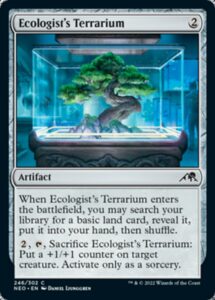Magic is full of staple effects that are reinvented over and over. Cards like Shock, Cancel, and Blade of the Sixth Pride are mainstay effects with room for a bit more power, and we see them functionally improved time and again. We get cards like Burst Lightning, Saw It Coming, and Daring Skyjek that showcase featured mechanics in a familiar format; designs like Voltage Surge, Wizard’s Retort, and Dwarfhold Champion indicate structural (often secondary) elements of a set without employing keywords; and cards like Play with Fire, Dissipate, and Cathar Commando are more generic improvements (which can subtly play into set themes).
These designs are crucial because they connect the familiar with the novel. They allow Magic to highlight innovation while providing known frameworks to help players both understand the card and focus on what’s new. Magic would be long gone if it chose not to print any more 2/2s for two mana simply because “it had enough already.” The math baked into the game system demands that certain effects show up over and over. And it demands that Magic’s designers find infinite ways to remix what have become hundreds of familiar tunes.
Ecologist’s Terrarium is a generally simple effect—an artifact that helps fix your colors. Most commonly, these designs are Traveler’s Amulet, Expedition Map, Renegade Map, or Wayfarer’s Bauble. They provide consistency to Limited and quietly enable synergies—Renegade Map is one of my favorite designs ever for how it enables Revolt and Improvise as well as greedy manabases. Sometimes, these cards provide an additional bonus, as with Horizon Spellbomb and Prophetic Prism. Sometimes, these are awful—see Mana Cylix and Navigator’s Compass. But despite almost thirty years of cards, we regularly see cards like Ecologist’s Terrarium that manage to do something new with entirely familiar components.
The innovation here is fairly subtle. We’ve seen plenty of artifacts fetch lands. We’ve seen them do it at two mana with Mycosynth Wellspring, Moonsilver Key, Armillary Sphere, and Campus Guide. We’ve seen them provide secondary effects or value simply by existing on the battlefield. But we rarely see such a card combined with a secondary effect that isn’t another form of drawing cards (and when we do, it’s usually colored card like Attune with Aether).
I love this bit of the design of Ecologist’s Terrarium. Sure, it’s generically good on its own and synergizes well with Neon Dynasty’s artifact, sacrifice, and Modified themes. But the core brilliance is how it encourages a balance between greed and aggression. Ecologist’s Terrarium isn’t great for focused aggressive decks, as they don’t want to waste two mana just to fetch a land (and a four mana +1/+1 counter is far too slow). 3+ color decks are happy to pay a premium for consistent colors, but smaller creatures benefit disproportionately more from a +1/+1 counter than larger ones. The optimal use case if a deck that’s both greedy and has small-to-midsized creatures that’ll really benefit from the upgrade. So, while the design is very open-ended, it gently nudges players towards a fairly narrow sweet spot, and it does so incredibly quietly.
I adore the craft that goes into updating staple, workhorse effects like Traveler’s Amulet into Ecologist’s Terrarium. Magic is a game that can never rest on its laurels, even for simple effects that are primarily meant as glue for Limited. Sure, Magic benefits from reprinting and reusing familiar effects from the outstanding Lightning Bolt to the meme Colossal Dreadmaw to the underwhelming Bramble Armor, but I get excited when Magic creates something we’ve never seen before, to perform a role we see constantly, all while using entirely familiar familiar parts. It’s not the sexiest part of game design, but it’s an essential puzzle piece in how Magic has managed to keep going strong as it approaches it thirtieth birthday, and one that’s worth learning from.
Zachary Barash is a New York City-based game designer and the commissioner of Team Draft League. He designs for Kingdom Death: Monster, has a Game Design MFA from the NYU Game Center, and does freelance game design. When the stars align, he streams Magic (but the stars align way less often than he’d like).


